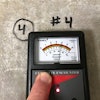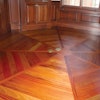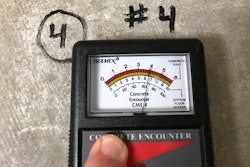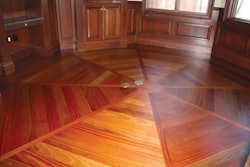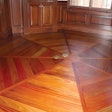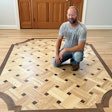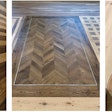The Problem
I was contacted by a home owner who had contracted to have a new American cherry solid strip floor installed. The customer was concerned about the contamination trapped between coats of polyurethane, as well as severe dog scratches throughout the floor. The situation had escalated from a simple screen and recoat to a full-blown $12,000 lawsuit.
The Procedure
From talking with the home owner and flooring contractor, I was able to ascertain that the designer on the project had originally suggested American cherry to match the cabinets in the kitchen. The customer suggested they look at the neighbor's Brazilian cherry floor. After a brief discussion, the designer and contractor talked the home owner into American cherry, saying it was just as durable as its Brazilian counterpart.
The installation was on-grade on a concrete slab. The flooring contractor applied tar and one layer of 15-pound felt as a moisture retarding system. He then put down plywood and installed the flooring. After installation, the floor acclimated for two weeks, and the floor was sanded and stained medium brown. During staining, the contractor noticed a blotchy appearance, which he brought to the attention of the customer. The customer said that because it was even throughout the floor, she could live with it. The stain dried, and three coats of polyurethane were applied—one coat each day for three days. After the last coat was dry, the customer noticed dust in the finish. The contractor agreed to rescreen and recoat. Unfortunately, his attempt failed, and the floor looked worse than before.
At this point, the home owner began to question the abilities of the contractor. Tension was building, and the contractor was not returning phone calls. The customer (and her dogs weighing in excess of 100 pounds each) needed to move back into a house with an unacceptable floor. Once the dogs moved in, severe scratches appeared in the finish and indentations were apparent in the wood floor surface. The home owner contacted an attorney, who recommended she contact a wood floor consultant and issue a formal complaint with the Contractors State License Board.
The Cause
I determined that this floor was installed, sanded and finished in an uncontrolled and contaminated environment. The contractor met almost no industry standards in his procedures. The flooring was delivered to a job site that did not have a controlled environment, and the material was not acclimated prior to installation. Additionally, the concrete slab was not tested for moisture transmission rate using one of the industry-approved methods—the calcium chloride test, rubber mat test, poly sheeting test or electronic meter testing. Only one layer of 15-pound felt paper over tar was used, not two as called for in the NWFA Installation Guidelines.
The sanding and finishing was done in an unstable environment, as evidenced by the fact that dust was visible stuck to the cabinet doors and toe kicks.
Now that there was a problem with scratches, the home owner claimed that she had wanted Brazilian cherry all along. She also claimed that the blotchy effect from the stain was unacceptable.
Because the contractor failed to respond to the customer complaint, he opened the door for others to scrutinize his process. Because he had no proper documentation, he was unable to defend his procedures in the event of the lawsuit.
How to Fix the Floor
If the client determines that American cherry is unacceptable, the entire floor needs to be reinstalled. If not, resanding and finishing the floor using correct procedures should take care of the problem.
In the Future
Collect information prior to starting the job: What are the client's expectations. Does she have small children or pets. This gives you a better understanding of what type of hardwood floor is suitable. Take the time to educate the client about the floor.
Properly document your job. Have the customer sign off on specie selection, as well as any other special considerations, such as layout. It is best to take photos of each process throughout the job. Document subfloor testing, moisture retarding systems used, nailing schedules and what types and lengths of fasteners were used. On a daily basis, document the temperature and relative humidity. Before flooring is delivered, make sure the job site is controlled and stable. Measure and record the moisture content of the flooring upon delivery to the job site, and do the same for the subfloor. Be sure the difference between the flooring and subfloor is no more than 4percent for strip (2 percent for plank). When a stain color is chosen, write down the manufacturer andc olor on the back of your contract, and have the customer sign it. Taking the time to document the job properly may sound like a lot of work, but it looks professional, and may also save thousands of dollars in the event of a lawsuit.













